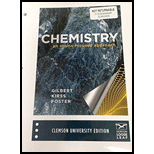
To:
a) Calculate
b) Calculate
c) Write an overall (combined)
d) Calculate the
Answer to Problem 12.69QA
Solution:
a) Calculated
b) Calculated
c) Overall (combined) chemical reaction from the first two given reactions is
d) Calculated the
Explanation of Solution
1) Concept:
We can use the concept second law of
2) Formulae:
i.
ii.
iii.
iv.
3) Given:
i. A steam-methane reforming reaction is given as:
ii. A water-gas shift reaction equation is given as:
iii.
4) Calculations:
a)
The steam-methane reforming reaction consumes 1 mole of methane and water each and produce 1 mole of carbon monoxide and 3 moles of hydrogen gas. Multiplying the
b)
The water-gas shift reaction consumes 1 mole of carbon monoxide and water each and produce 1 mole of carbon dioxide and 1 moles of hydrogen gas. Multiplying the
c) Overall reaction by combining the two given equations is:
+
d)
The overall reaction is:
The above reaction consumes 1 mole of methane gas and 1 mole of water vapor producing 1 mole of carbon dioxide and 4 moles of hydrogen gas. Multiplying the
The deltaG reaction
Conclusion:
a) Calculated
b) Calculated
c) Overall (combined) chemical reaction from the first two given reactions is
d) Calculated the
Want to see more full solutions like this?
Chapter 12 Solutions
Chemistry: An Atoms-Focused Approach
 ChemistryChemistryISBN:9781305957404Author:Steven S. Zumdahl, Susan A. Zumdahl, Donald J. DeCostePublisher:Cengage Learning
ChemistryChemistryISBN:9781305957404Author:Steven S. Zumdahl, Susan A. Zumdahl, Donald J. DeCostePublisher:Cengage Learning ChemistryChemistryISBN:9781259911156Author:Raymond Chang Dr., Jason Overby ProfessorPublisher:McGraw-Hill Education
ChemistryChemistryISBN:9781259911156Author:Raymond Chang Dr., Jason Overby ProfessorPublisher:McGraw-Hill Education Principles of Instrumental AnalysisChemistryISBN:9781305577213Author:Douglas A. Skoog, F. James Holler, Stanley R. CrouchPublisher:Cengage Learning
Principles of Instrumental AnalysisChemistryISBN:9781305577213Author:Douglas A. Skoog, F. James Holler, Stanley R. CrouchPublisher:Cengage Learning Organic ChemistryChemistryISBN:9780078021558Author:Janice Gorzynski Smith Dr.Publisher:McGraw-Hill Education
Organic ChemistryChemistryISBN:9780078021558Author:Janice Gorzynski Smith Dr.Publisher:McGraw-Hill Education Chemistry: Principles and ReactionsChemistryISBN:9781305079373Author:William L. Masterton, Cecile N. HurleyPublisher:Cengage Learning
Chemistry: Principles and ReactionsChemistryISBN:9781305079373Author:William L. Masterton, Cecile N. HurleyPublisher:Cengage Learning Elementary Principles of Chemical Processes, Bind...ChemistryISBN:9781118431221Author:Richard M. Felder, Ronald W. Rousseau, Lisa G. BullardPublisher:WILEY
Elementary Principles of Chemical Processes, Bind...ChemistryISBN:9781118431221Author:Richard M. Felder, Ronald W. Rousseau, Lisa G. BullardPublisher:WILEY





